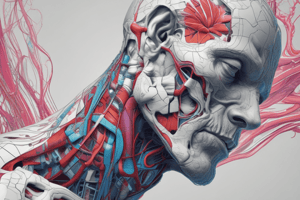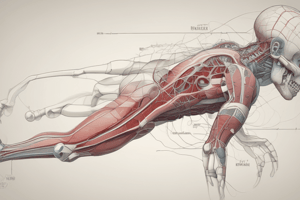Podcast
Questions and Answers
What is the function of the Circulatory system?
What is the function of the Circulatory system?
- To protect the body from external damage
- To transport oxygen and nutrients to cells (correct)
- To produce hormones
- To digest food
Which body cavity contains the brain and spinal cord?
Which body cavity contains the brain and spinal cord?
- Dorsal body cavity (correct)
- Pelvic cavity
- Thoracic cavity
- Abdominal cavity
What direction is inferior?
What direction is inferior?
- Below (correct)
- To the side
- Above
- Towards the front
What is the purpose of the Integumentary system?
What is the purpose of the Integumentary system?
What plane divides the body into left and right halves?
What plane divides the body into left and right halves?
What is the position of the body in the Anatomical position?
What is the position of the body in the Anatomical position?
The sequence of amino acids in a protein is determined by the environment.
The sequence of amino acids in a protein is determined by the environment.
α-Helix is a type of secondary structure characterized by a flat, extended shape.
α-Helix is a type of secondary structure characterized by a flat, extended shape.
Hydrophobic interactions are responsible for the formation of disulfide bonds.
Hydrophobic interactions are responsible for the formation of disulfide bonds.
Quaternary structure is only important for protein stability, not for protein function.
Quaternary structure is only important for protein stability, not for protein function.
Chaperone proteins are involved in the degradation of misfolded proteins.
Chaperone proteins are involved in the degradation of misfolded proteins.
The primary structure of a protein determines the overall 3D shape of the protein.
The primary structure of a protein determines the overall 3D shape of the protein.
Flashcards are hidden until you start studying
Study Notes
Organ Systems
- Nervous system: brain, spinal cord, nerves
- Circulatory system: heart, blood vessels, blood
- Respiratory system: lungs, trachea, bronchi
- Digestive system: mouth, esophagus, stomach, small intestine, large intestine
- Endocrine system: glands that produce hormones (e.g. thyroid, pancreas, adrenal glands)
- Integumentary system: skin, hair, nails, sweat glands
- Muscular system: skeletal muscles, smooth muscles, cardiac muscles
- Skeletal system: bones, joints, ligaments
- Urinary system: kidneys, ureters, bladder, urethra
Body Regions
- Axial body: head, neck, thorax, abdomen, pelvis
- Appendicular body: upper limbs, lower limbs
- Cranial cavity: contains the brain
- Thoracic cavity: contains the heart, lungs
- Abdominal cavity: contains the digestive organs
- Pelvic cavity: contains the reproductive organs, urinary bladder
Body Cavities
- Dorsal body cavity: contains the brain and spinal cord
- Ventral body cavity: contains the thoracic and abdominopelvic cavities
- Thoracic cavity: contains the heart, lungs
- Abdominopelvic cavity: contains the digestive organs, urinary bladder, reproductive organs
Directional Terms
- Anterior: front
- Posterior: back
- Superior: above
- Inferior: below
- Lateral: side
- Medial: middle
- Proximal: near the trunk
- Distal: away from the trunk
- Supine: lying on the back
- Prone: lying on the stomach
Anatomical Position
- Standing upright with feet together
- Arms at the sides with palms facing forward
- Head, eyes, and toes facing forward
Body Planes
- Sagittal plane: divides the body into left and right halves
- Frontal plane: divides the body into anterior and posterior halves
- Transverse plane: divides the body into superior and inferior halves
Protein Structure
Primary Structure
- Amino acid sequence determines overall protein properties
- Sequence is written from N-terminus to C-terminus
- Genetic code determines amino acid sequence
Secondary Structure
- α-Helix: spiral shape, stabilized by hydrogen bonds
- β-Sheet: flat, extended shape, stabilized by hydrogen bonds
- Hydrogen bonds between amino acids stabilize secondary structure
Tertiary Structure
- Overall 3D shape of a protein, determined by amino acid interactions
- Hydrophobic interactions: non-polar amino acids avoid water and interact with each other
- Ionic interactions: charged amino acids interact with each other
- Disulfide bonds: covalent bonds between cysteine residues
- Hydrogen bonds: between polar amino acids
Quaternary Structure
- Multi-polypeptide chain proteins (subunits) interact to form a functional protein
- Subunit interactions are important for protein function and stability
Protein Folding
- Process by which a protein achieves its native conformation
- Chemical interactions between amino acids influence protein folding
- Hydrophobic and ionic interactions influence protein folding
- Chaperone proteins assist in protein folding
- Misfolded proteins can be dysfunctional or toxic
Studying That Suits You
Use AI to generate personalized quizzes and flashcards to suit your learning preferences.





